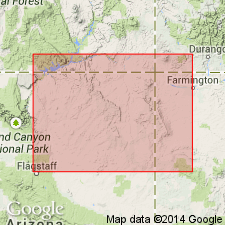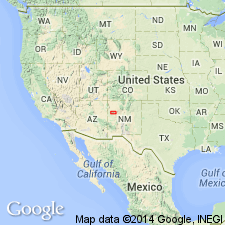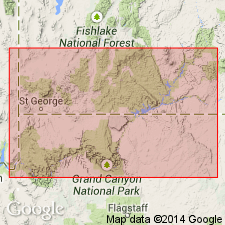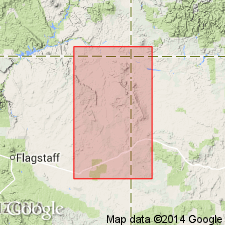
- Usage in publication:
-
- Lukachukai member*
- Modifications:
-
- Principal reference
- Dominant lithology:
-
- Sandstone
- AAPG geologic province:
-
- Black Mesa basin
- Paradox basin
- San Juan basin
Summary:
Pg. 3 (fig. 2), 8 (fig. 5), 10-12, pl. 2. Lukachukai member of Wingate sandstone of Glen Canyon group. Pale reddish-brown, fine- to very fine-grained sandstone at type locality. Lithology homogenous throughout Navajo country. Limestone lenses locally common in area between Chinle, Arizona, and the Four Corners State junction (northeastern Arizona, western Colorado, northwestern New Mexico, and eastern Utah). Massive cross-bedded sandstone that weathers into sheer cliffs above slope forming Rock Point member. Intertongues with Rock Point member in type area. Constitutes lower half of original Wingate sandstone as defined by [Dutton, 1885]; underlies Entrada sandstone. Intertongues with Dinosaur Canyon sandstone member of Moenave formation in extreme southwestern part of Navajo country. Thickness about 300 feet throughout Navajo country. From Fort Wingate eastward, progressively thinner and pinches out within 30 miles south of Laguna, New Mexico. Thins and pinches out to west and south as well as to east of Navajo country. Northwestward along Ward Terrace it disappears between Chinle and basal member of Moenave formation. Age is Late Triassic. Type locality designated.
Type locality: sandstone that forms vertical cliff on escarpment northeast of Lukachukai, Apache Co., northeastern AZ. Present throughout most of the Navajo Indian Reservation.
[Typographical error (US geologic names lexicon, USGS Bull. 1200, p. 2274): original Wingate defined by Dutton (USGS 6th Ann. Rpt., 1885), not Darton.]
Source: Publication; US geologic names lexicon (USGS Bull. 1200, p. 2274).

- Usage in publication:
-
- Lukachukai Member*
- Modifications:
-
- Not used
Summary:
Use of name Lukachukai Member of Wingate Sandstone of Glen Canyon Group in the Gallup-Grants area, McKinley Co, NM, San Juan basin, discontinued in preference to the newly named Iyanbito Member of Entrada Sandstone of San Rafael Group. The sequence of rocks represented--continental red-orange cross-bedded sandstone, reddish-brown sandy siltstone, and claystone--ranges from 12 to 44.2 m thick. The sequence was previously thought to be separated from the Entrada by an unconformity. The sequence is now thought to be separated from the underlying Owl Rock Member of the Chinle Formation by an unconformity and to conformably underlie the middle siltstone member of the Entrada. Measured section of Iyanbito; cross section; nomenclature chart. The unconformity at the base of the Iyanbito is marked by occurrence of chert pebbles. [This nomenclature change removes all rocks in the "Wingate cliffs" 1.2 mi north of Wingate Station from the Wingate Sandstone and places the lowest part of all of Dutton's Wingate Sandstone in the Entrada Sandstone.]
Source: GNU records (USGS DDS-6; Denver GNULEX).

- Usage in publication:
-
- Lukachukai Member*
- Modifications:
-
- Overview
- AAPG geologic province:
-
- Black Mesa basin
- San Juan basin
Summary:
Is upper member of Wingate Sandstone of Glen Canyon Group in northeast AZ, Black Mesa basin and northwest NM, San Juan basin. Is the eastern equivalent of lower part of Dinosaur Canyon Sandstone Member of Moenave Formation of Glen Canyon. Tentatively assigned to Sinemurian or Early Jurassic on the basis of Early Jurassic palynomorphs identified from Whitmore Point Member, middle member of Moenave. [Age retained by USGS as Late Triassic]. Correlation chart.
Source: GNU records (USGS DDS-6; Denver GNULEX).

- Usage in publication:
-
- Lukachukai Member*†
- Modifications:
-
- Abandoned
Summary:
Name was applied to the eolian sandstone upper part of the Wingate Sandstone. Over the years since it was named, the term Lukachukai has been used only locally in a few papers. The lower part of the Wingate, the Rock Point Member which has been used in northwest NM and northeast AZ as a member, is much more limited distribution than the eolian sandstone. Because the older Rock Point is removed from the Wingate and assigned to the underlying Chinle Formation in this report, two names--Lukachukai and Wingate--can be applied to the same eolian sandstone. Wingate is a term used in many reports on CO, UT, AZ, and NM and is the term given precedence. Name Lukachukai abandoned.
Source: GNU records (USGS DDS-6; Denver GNULEX).
For more information, please contact Nancy Stamm, Geologic Names Committee Secretary.
Asterisk (*) indicates published by U.S. Geological Survey authors.
"No current usage" (†) implies that a name has been abandoned or has fallen into disuse. Former usage and, if known, replacement name given in parentheses ( ).
Slash (/) indicates name conflicts with nomenclatural guidelines (CSN, 1933; ACSN, 1961, 1970; NACSN, 1983, 2005, 2021). May be explained within brackets ([ ]).

